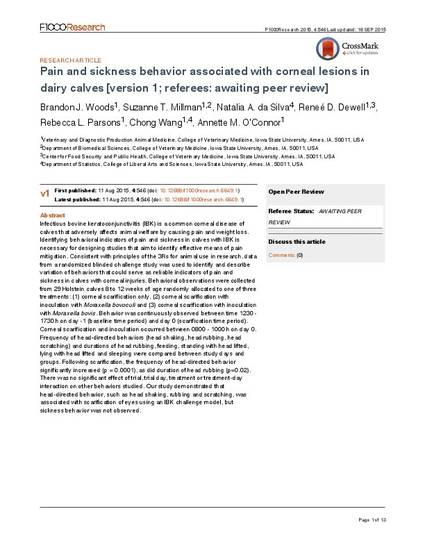
Article
Pain and Sickness Behavior Associated with Corneal Lesions in Dairy Calves
F1000Research
Document Type
Article
Disciplines
Publication Version
Published Version
Publication Date
1-1-2015
DOI
10.12688/f1000research.6649.1
Abstract
Infectious bovine keratoconjunctivitis (IBK) is a common corneal disease of calves that adversely affects animal welfare by causing pain and weight loss. Identifying behavioral indicators of pain and sickness in calves with IBK is necessary for designing studies that aim to identify effective means of pain mitigation. Consistent with principles of the 3Rs for animal use in research, data from a randomized blinded challenge study was used to identify and describe variation of behaviors that could serve as reliable indicators of pain and sickness in calves with corneal injuries. Behavioral observations were collected from 29 Holstein calves 8 to 12 weeks of age randomly allocated to one of three treatments: (1) corneal scarification only, (2) corneal scarification with inoculation with Moraxella bovoculi and (3) corneal scarification with inoculation with Moraxella bovis. Behavior was continuously observed between time 1230 - 1730 h on day -1 (baseline time period) and day 0 (scarification time period). Corneal scarification and inoculation occurred between 0800 - 1000 h on day 0. Frequency of head-directed behaviors (head shaking, head rubbing, head scratching) and durations of head rubbing, feeding, standing with head lifted, lying with head lifted and sleeping were compared between study days and groups. Following scarification, the frequency of head-directed behavior significantly increased (p = 0.0001), as did duration of head rubbing (p=0.02). There was no significant effect of trial, trial day, treatment or treatment-day interaction on other behaviors studied. Our study demonstrated that head-directed behavior, such as head shaking, rubbing and scratching, was associated with scarification of eyes using an IBK challenge model, but sickness behavior was not observed.
Rights
This is an open access article distributed under the terms of the Creative Commons Attribution Licence, which permits unrestricted use, distribution, and reproduction in any medium, provided the original work is properly cited. Data associated with the article are available under the terms of the Creative Commons Zero "No rights reserved" data waiver (CC0 1.0 Public domain dedication).
Copyright Owner
Brandon J. Woods, et al.
Copyright Date
2015
Language
en
File Format
application/pdf
Citation Information
Brandon J. Woods, Suzanne T. Millman, Natalia da Silva, Reneé Dewell, et al.. "Pain and Sickness Behavior Associated with Corneal Lesions in Dairy Calves" F1000Research Vol. 4 (2015) p. 1 - 13 Available at: http://works.bepress.com/chong-wang/6/

This article is from F1000Research 5 (2015): 546, doi:10.12688/f1000research.6649.1. Posted with permission.